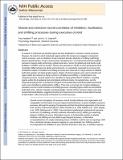Shared and selective neural correlates of inhibition, facilitation, and shifting processes during executive control
Author(s)
Hedden, Trey; Gabrieli, John D. E.
DownloadGabrieli-2010-Shared and selective neural correlates of inhibition, facilitation, and shifting processes during executive control.pdf (2.547Mb)
OPEN_ACCESS_POLICY
Open Access Policy
Creative Commons Attribution-Noncommercial-Share Alike
Terms of use
Metadata
Show full item recordAbstract
A network of prefrontal and parietal regions has been implicated in executive control processes. However, the extent to which individual regions within this network are engaged in component control processes, such as inhibition of task-irrelevant stimulus attributes or shifting (switching) between attentional foci, remains controversial. Participants (N = 17) underwent functional magnetic resonance imaging while performing a global–local task in which the global and local levels could facilitate or interfere with one another. Stimuli were presented in blocks in which participants either constantly shifted between the global and local levels, or consistently responded to one level only. Activations related to inhibition and shifting processes were observed in a large network of bilateral prefrontal, parietal, and basal ganglia regions. Region of interest analyses were used to classify each region within this network as being common to inhibition and shifting, or preferential to one component process. Several regions were classified as being preferential to inhibition, including regions within the dorsolateral and ventrolateral prefrontal cortex, the parietal lobes, and the temporal–parietal junction. A limited set of regions in the parietal lobes and left dorsolateral prefrontal cortex were classified as preferential to shifting. There was a very large set of regions displaying activation common to both inhibition and shifting processes, including regions within the dorsolateral prefrontal cortex, anterior cingulate, and basal ganglia. Several of these common regions were also involved during facilitation, suggesting that they are responsive to the number of task-salient channels of information, rather than purely to demands on control processes.
Date issued
2010-02Department
Massachusetts Institute of Technology. Department of Brain and Cognitive Sciences; McGovern Institute for Brain Research at MITJournal
NeuroImage
Publisher
Elsevier
Citation
Hedden, Trey, and John D.E. Gabrieli. “Shared and Selective Neural Correlates of Inhibition, Facilitation, and Shifting Processes During Executive Control.” NeuroImage 51.1 (2010): 421–431. Web. 5 Apr. 2012.
Version: Author's final manuscript
ISSN
1053-8119
1095-9572